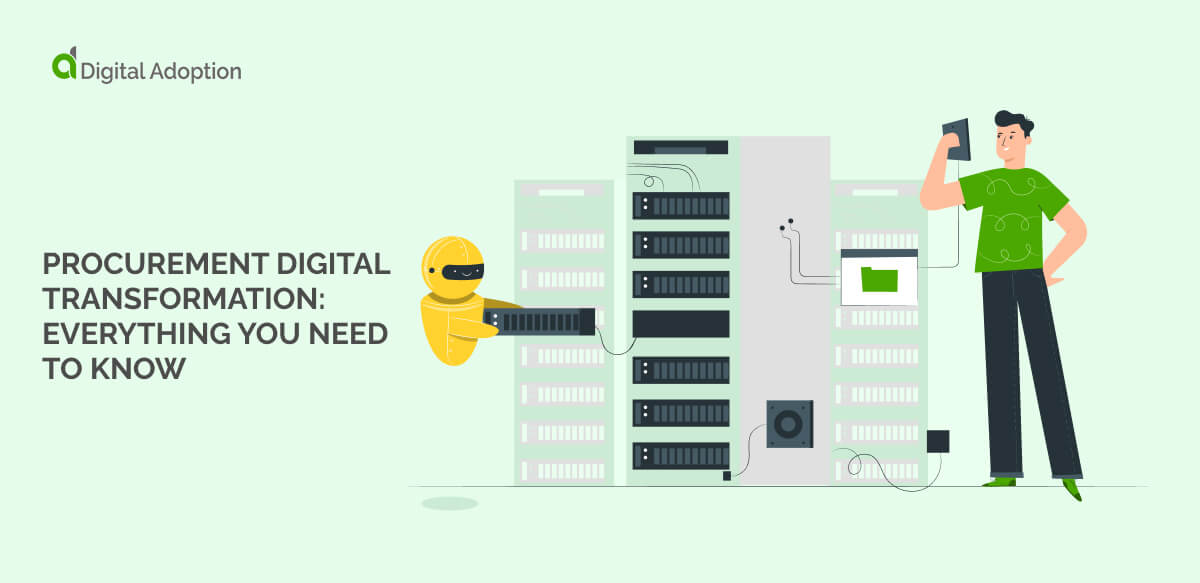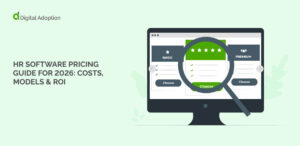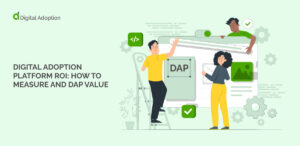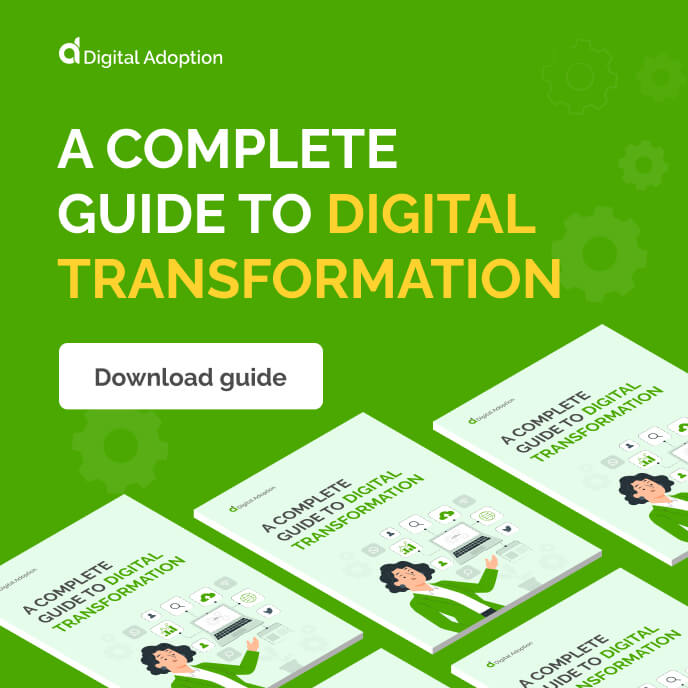Digital transformation (DX) is impacting every part of the business world, from enhancing business-critical operations to restructuring long-standing work models.
These changes are also extending into modern procurement processes that reimagine supply chain management, vendor selection, and key purchasing decisions.
Through digital tools such as e-procurement and supplier relationship management platforms, along with AI adoption, the current state of procurement is ripe for transformation.
New technologies are changing the procurement process. Inefficiencies with manual processes, spend visibility, and long cycle times can all be improved with up-to-date software solutions.
This article will highlight how digital transformation enhances procurement mechanisms for digitally driven businesses. We’ll discuss technology’s role, benefits, challenges, and how to improve sourcing strategies.
- What is procurement in digital transformation?
- What processes does procurement in digital transformation improve?
- What technologies are driving procurement in digital transformation?
- What are the benefits of procurement digital transformation?
- What are the challenges of procurement in digital transformation?
- How to build a procurement digital transformation strategy
- What should you include in your procurement digital transformation roadmap?
- What are the future trends in procurement digital transformation?
- How to overcome procurement in digital transformation roadblocks
- People Also Ask
What is procurement in digital transformation?
Procurement in digital transformation is the implementation of digital technologies to overhaul traditional, analogue, and paper-based procurement processes.
It involves utilizing procurement software (e.g., e-procurement systems), AI automation, blockchain, and other innovative solutions to restructure legacy purchasing strategies.
This shouldn’t be confused with procuring technology, i.e., the tech buying process, which is a different issue altogether. That specifically focuses on purchasing disruptive technology, such as AI, rather than examining or improving the efficiency of those buying mechanisms.
Across the procurement system, there are many risks of inefficiencies. Traditionally, procurement was a manual process full of inefficient processes. Manual paperwork, fragmented data, and poor spending visibility all create challenges.
Procurement in DX tackles this by reconfiguring the end-to-end procurement process. It enhances the means to identify the need for goods or services, source potential suppliers, negotiate contracts, make purchasing decisions, and manage supplier relationships.
What processes does procurement in digital transformation improve?
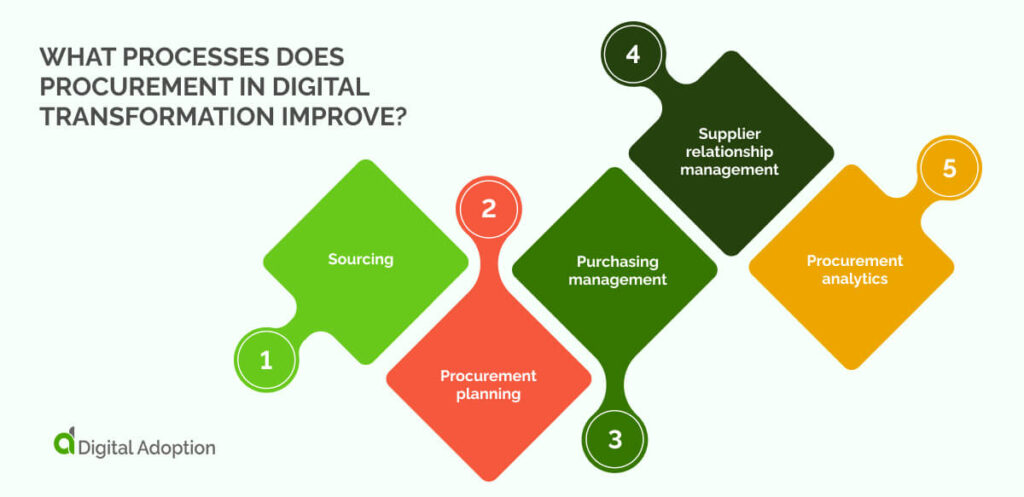
The procurement processes that DX efforts can impact the most are comprehensive, with almost all segments of the cycle able to benefit from digital overhauls. From sourcing to managing contracts to streamlined purchasing workflows, each area becomes more agile and precise.
Below, we examine the main procurement functions DX is helping bring up to speed.
Sourcing
Procurement no longer relies on static lists of suppliers. Selection adapts in real time, shaped by delivery records, financial health, and shifting market risks. AI updates supplier profiles automatically, flagging weak links before they snowball into bigger problems. As markets shift, the system directs procurement teams toward partners with proven records, not just those who look good on paper.
Procurement planning
Annual procurement plans break down under pressure from real-world changes. Instead of setting a plan once, real-time data now feeds into daily decisions. Forecasting adjusts to supplier delays, market shortages, and sudden demand spikes. AI tracks consumption trends alongside external events, such as strikes or weather, guiding teams to order only what they need, when they need it.
Purchasing management
Orders no longer wait for manual approvals. Automated triggers kick in as stock levels drop, placing purchases before gaps turn into delays. Real-time insights reveal early signs of supply issues, so teams can act before shelves run out. Purchases flow from demand, not from outdated schedules or guesswork by suppliers.
Supplier relationship management
Supplier management moves from gut feel to hard numbers. Performance gets tracked live, not just reviewed once a year. Data shows that when a supplier slips, bigger problems follow. Contracts adjust based on actual output, helping teams back the right partners while scaling back risk quietly and early.
Procurement analytics
Analytics now run in the background, catching waste that manual reviews miss. Spend patterns, supplier habits, and contract gaps surface through automated scans. Instead of chasing problems after they grow, teams spot inefficiencies early and course-correct before costs pile up.
What technologies are driving procurement in digital transformation?
Decades of innovative tech development have paved new paths, allowing procurement processes to keep pace with the speed required by businesses today.
Whether targeting procurement pain points with a single solution or a combination of several, the examples below highlight how updated processes wouldn’t be possible without various key technologies. Let’s take a closer look:
| Technology | Procurement Benefit |
| E-Procurement Systems | Centralize purchase orders, contract workflows, and approvals into traceable systems that flag non-compliant activity immediately. |
| Spend Analytics Platforms | Break down invoices, supplier terms, and payment cycles to surface redundant spending and uncover missed rebate triggers. |
| Supplier Relationship Management (SRM) Systems | Track supplier performance, dispute histories, certifications, and risk exposure using real-time scoring models. |
| Mobile Procurement Apps | Enable sourcing, approvals, and invoice management via secure mobile devices without disrupting audit trails. |
| Risk and Compliance Solutions | Compile third-party financials, operational risks, and regulatory exposures to preempt supplier disruptions. |
| AI and Machine Learning (ML) | Detect contract anomalies, automate vendor suggestions, and predict bottlenecks using historical trend data. |
| Robotic Process Automation (RPA) | Auto-fill purchase requisitions, vendor onboarding, and invoice reconciliation with machine-triggered workflows. |
| Demand Forecasting Analytics | Predict inventory needs by analyzing consumption rates, seasonality, and external disruption signals. |
| Supplier Networks and Marketplaces | Expand sourcing through searchable catalogs of vetted suppliers in real time. |
| Cybersecurity and Data Safeguards | Secure procurement transactions and communications from breaches or tampering. |
| Blockchain and Smart Contracts | Authenticate transactions and enforce supplier terms without traditional intermediaries. |
What are the benefits of procurement digital transformation?
Implementing digital transformation is costly, requiring investments in software, hardware, and ongoing user training. But it’s not just hype. Statista reports that global digital transformation spending is expected to hit $2.5 trillion in 2024 and will rise to $3.9 trillion by 2027.

E-procurement solutions bring major business benefits. Here, we’ll examine four top reasons for implementing digital transformation in procurement: risk management, process improvement, cost optimization, and relationship building.
Risk management
Better risk management is one of the main drivers for digital transformation in procurement today, giving never-before-seen transparency into supplier performance, compliance, and market conditions.
It supports organizations’ ability to assess and mitigate supplier disruptions, compliance violations, or market shifts through auto-alerts, AI-derived data analytics, and supplier collaboration tools.
Improve processes
As we’ve already mentioned, procurement typically involves many inefficient processes. Digital transformation improves process efficiency by automating manual tasks, eliminating paperwork, and enabling streamlined workflows.
It improves strategic sourcing, reduces cycle times, minimizes errors, and enhances productivity through features such as e-procurement systems, electronic approvals, automated document management, and real-time data access, resulting in faster, more efficient procurement operations.
Do the same things as before (but cheaper)
Digital transformation in this field can also save costs compared to legacy systems. Digital procurement drives cost reduction by optimizing sourcing strategies, streamlining processes, and enabling data-driven decision-making.
It helps organizations identify cost-saving opportunities, negotiate favorable terms with suppliers, reduce maverick spending, and improve contract management, resulting in lower procurement costs and increased savings. Progress in many business areas shows clearly that DX can dramatically reduce operational costs, and procurement is no exception.
Build better relationships
Furthermore, there are benefits to vendor management in digital procurement. Digital procurement fosters strategic relationship building with suppliers by providing tools for enhanced collaboration, performance monitoring, and communication.
This facilitates sharing information, joint problem-solving, and innovation, leading to stronger partnerships, improved supplier engagement, and the ability to leverage supplier expertise for mutual benefits.
What are the challenges of procurement in digital transformation?
Of course, it’s not easy to produce the best results from digital procurement transformation.
Whatever your starting point is, every company needs to implement a solid technology adoption strategy and develop a good understanding of change management principles.
Fortunately, many procurement departments have undergone digital transformation, and we can learn from their successes and failures. There are three key issues: realizing long-term ROI, cybersecurity, and unpredictable legislation.
Digital transformation ROI takes time
Unfortunately, DX is not a quick fix. A McKinsey guide to digital procurement explains it clearly: “Digital procurement transformation is like a marathon in which many companies drop out of the race early on, failing to get beyond an initial set of pilots.”
There’s no question that DX initiatives in procurement require major investments in technology, infrastructure, and process redesign. As a result, it may take time to fully integrate and optimize these new systems, train users, and overcome any resistance to change.
Organizations may experience a delay in realizing the return on investment (ROI) associated with their digital procurement initiatives. It pays to be patient, but not every company has this resilience.
Cybersecurity issues
Digital transformation introduces new vulnerabilities and cybersecurity risks. As procurement processes become more digital and interconnected, organizations must address the challenge of protecting sensitive procurement data from cyber threats, including data breaches, hacking attempts, ransomware attacks, and unauthorized access.
Establishing enhanced cybersecurity measures, implementing secure systems, and ensuring employee awareness and training are critical to safeguarding procurement data and systems.
Changing legislative landscape
Procurement activities are subject to various legal and regulatory requirements that can pose challenges during digital transformation. Organizations must navigate compliance with data protection and privacy laws, industry-specific regulations, international trade regulations, and other legal frameworks.
Adapting digital procurement processes and systems to align with evolving legislation, ensuring data privacy and security, and managing compliance risks are key considerations in the digital transformation journey.
How to build a procurement digital transformation strategy
We’ve evaluated the pros and cons of modernizing procurement through transformation initiatives. Let’s look at key components needed to build an effective strategy.
A well-defined strategy acts as the basis for procurement transformation. It helps guide decisions, coordinates efforts across teams, and maintains focus on overarching priorities.
Strategic assessment and roadmap
Begin with a strategic audit: map existing procurement processes, identify bottlenecks, and align executive stakeholders on clear goals. Define governance and a phased roadmap of prioritized initiatives. This establishes baselines and success metrics before new technologies are deployed.
Systems integration and automation
Integrate procurement applications into a unified architecture. For example, link ERP and e-procurement systems so that orders, approvals, and invoices synchronize automatically. Implement low-code or no-code workflow tools to digitize routine tasks, such as auto-routing purchase requests to managers based on contract terms.
Process standardization and training
Simultaneously, standardize core workflows to ensure consistency and compliance (for example, formalizing supplier onboarding with built-in risk checks). Invest in comprehensive training and change management so teams can adapt to new tools. Experts note that procurement transformation spans multiple levels and requires leadership engagement.
Performance measurement and refinement
Finally, deploy analytics and KPIs to monitor adoption and outcomes. With procurement integrated end-to-end, teams leverage unified data for real-time visibility into spend and supplier performance. Use dashboards to track metrics, such as cycle time, compliance, and cost, and iteratively refine your processes.
What should you include in your procurement digital transformation roadmap?
Each procurement transformation demands strategies tailored to specific pain points. However, several industry-recognized steps consistently serve as foundational precursors. Here’s a breakdown of core components to include in a procurement digital transformation roadmap.
Modernize procurement workflows with no-code automation
Deploy no-code tools to reconfigure purchase approvals, supplier onboarding, and invoice validation without IT intervention. Build conditional logic into workflows to auto-route requests based on contract thresholds or vendor performance.
Consolidate procurement systems into a single source
Integrate e-procurement, contract management, and ERP platforms to eliminate manual reconciliation. Sync purchase orders, receipts, and payments in real time to maintain consistent records across departments.
Codify procurement standards across functions
Draft step-by-step procedural guides for sourcing, vendor onboarding, and contract approvals. Enforce uniform templates and approval matrices to lower audit risks and standardize compliance checks.
Develop procurement-specific technical skills.
Train procurement teams in systems integration, contract analytics, and e-sourcing platforms. Focus skill development on tool configuration, data validation techniques, and automated reporting frameworks to reduce dependency on external IT resources.
Digitize supplier communication channels
Adopt secure supplier portals for contract updates, bid submissions, and delivery tracking. Replace fragmented email chains with centralized platforms to control document versioning and communication logs.
What are the future trends in procurement digital transformation?
Digital technology, business priorities, and procurement processes continue shifting. Four trends stand out: procurement performance measurement, speculation about disruptive technology, growth in data analytics, and a focus on cybersecurity.
Let’s take a look at each aspect in turn.
Procurement performance metrics
Procurement metrics have expanded beyond looking at cost savings. Organizations now track contract compliance rates, cycle times, and supplier resilience under pressure. Payment term consistency, delivery reliability, and purchase order accuracy are also standard measures. Regular audits against these benchmarks identify structural inefficiencies early and help avoid entrenched performance gaps.
New hype
The technological hype has changed. The mania for blockchain and NFTs has faded. While blockchain offered use cases across supply chain management, adoption in procurement never materialized. Meanwhile, speculation now points toward ChatGPT and generative AI. Procurement leaders who watch AI developments closely may find real applications, especially in sourcing, contract review, and risk analysis.
Data for decision-making (and more)
Data analytics continues to prove its value. With large volumes generated throughout the procurement lifecycle, analytics can uncover patterns in supplier performance, category inflation, and sourcing risks. High-quality procurement analytics requires clean datasets and strong query layers to make information actionable rather than overwhelming.
Cybersecurity
Cybersecurity demands grow heavier as procurement digitizes. Supplier portals, contract management tools, and payment systems present clear attack surfaces. Cyber audits of suppliers and internal systems are now a standard step to guard sensitive procurement data and avoid downstream vulnerabilities.
How to overcome procurement in digital transformation roadblocks
This article has shown you the basis for digital procurement transformation. For a quick reminder, that means:
- Digital transformation has serious implications for procurement.
- Successful digital transformation in procurement brings in major benefits (but it is not without its challenges for procurement leaders).
- The landscape of procurement technology is constantly changing, so stay up to date.
As a final point, let’s face it: digital workplaces are increasingly complex. Every employee uses multiple digital technologies every day. If you add new procurement software alongside everything else, there’s a high risk of creating extra roadblocks to overcome: poor training, inefficient software usage, and more.
That’s where a digital adoption platform can help. It can support your training demands, provide valuable insights into employee usage, and ensure your software solutions run efficiently. A DAP could be your friend if your digital transformation efforts are difficult to monitor.
People Also Ask
-
How does automation reshape procurement in digital transformation efforts?Automation restructures procurement by converting manual tasks, such as contract approvals, invoice matching, and supplier verifications, into programmed sequences. Source-to-pay systems pre-validate documentation against contract terms, cutting duplicate invoice disputes at their origin. Automated catalog updates prevent outdated pricing from being entered into supplier portals.
-
In what ways does AI sharpen procurement efficiency and accuracy?AI recalibrates procurement by cross-referencing supplier certifications, financial stability, and delivery records in real-time. Machine learning models assess supplier risk based on late shipment patterns, litigation history, and insurance lapses, generating supplier scores without the need for manual audits
-
How does digital transformation contribute to more sustainable procurement practices?Digital transformation embeds environmental compliance by flagging vendors that lack emissions disclosures, waste certifications, or proof of ethical sourcing. Data lakes integrate supplier audits, exposing inconsistencies between reported and actual sustainability practices across tier-2 and tier-3 suppliers.

 FACT CHECKED
FACT CHECKED